
the "happiness in slavery" suite
by terry hickman

the "happiness in slavery" suite
by terry hickman
Disturbing, thought-provoking, and ultimately -- for this artist accused of nihilism -- surprising. In this article, I want to relate what I found at the center of this jungle.
Reznor's "slave" screams in a void. The first two words of Broken: H.I.S. blast into consciousness without benefit of description: not "a slave," not "the slave," just "slave," without past, future, or any kind of context, he screams. Who is he, where is he, and what the hell is he screaming about?
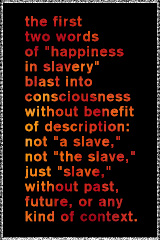
Broken is usually referred to as the album that's a wall of rage. Certainly the intensity of "Happiness In Slavery" makes its anger clear. And contempt...and fear?
It works as your standard rock-music complaint against conformity -- even if the depth of the rage puts it a few notches beyond the usual "don't push me around" lament. It appeals to that in the listener that makes her feel just a bit better than the common herd of lemmings that make up American society, that which makes her think her level of "awareness" -- of the "real" world and her own self -- is higher than that of the consumption-mad drones all around. "Don't open your eyes, you won't like what you see" -- but I can take it, I'm not like all you other hypocritical sods.
That's just the nicest part of this particular hell.
If you follow Mr. Reznor down through the labyrinth of his H.I.S. "suite," he'll lead you eventually to the one question none of us wants to ask.
Peel away another layer. From interviews and rock pundits we learn that at about the time Broken was a-birthing Reznor was suffering through what looked like the demise of his barely started artistic career. A perfectly understandable source of rage. While there's no way to know what was said in conversations between him and the record company he felt was cutting him off at the knees, it's easy to imagine that some of the lyrics to H.I.S. may have come directly from the lips of the executives "without a fucking clue": "He thinks he knows what he wants... Thinks he has something to say... Hears but doesn't want to listen... Being beat into submission... He's going to cause the system to fall... But he's glad to be chained to that wall." In many of his songs Reznor slithers easily around inside shifting points of view. These lyrics could be screaming in indignant mimicry of the fools -- or they could be Reznor looking at himself through the cool eyes of those in power over him. The facile, familiar exhortation to see yourself as others see you is a razor in disguise -- once achieved, how easy it would be to take this distant, scornful view of yourself and turn it inward. So is that contempt -- so evident in H.I.S. -- aimed at "society," at the conforming, self-deluding "slave"...or at the singer himself?
"Don't open your eyes, you won't like what you see, the blind have been blessed with security." The security of believing that what you've got to say is important, that anybody wants to hear it. You can be happy in that blindness. But once you've opened yourself to the knowledge of just how important you are in this world, you shrink to nothing ("The devils of truth steal the souls of the free"). The despairing poem "I don't know what I am, I don't know where I've been..." shatters the slave's delusions like a breaking mirror.
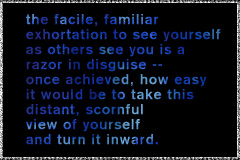
The final measures of the song inject a novel concept. The slowly closing chant "Happiness -- it controls you" against the grating background of inhuman screams of "Slavery!" leading to the last, numb whisper, "It controls you": Who else in our ever-consuming, endlessly avoiding, materialism-as-narcotic society has suggested that happiness -- not its pursuit, but its very concept -- controls you? And if that's true, what then are we left to pursue?
My generation (the -- ugh -- Boomers) seem to have settled down into a pack of comfort-seeking, pain-avoiding hypocrites. Too many of us spend all our time and energy trying never to feel want, hardship, or discomfort and have tried to raise our kids protected from all that, too. It is to their credit that the next generation seems to see through all that. They don't seem to have been spared much pain, however; one trend in my son's generation that I wonder about is the deliberate self-infliction of pain, manifested in body-piercing, carving, tattooing and branding. Whether this is an attempt to get one's outsides to match one's pain-wracked insides, and/or how much of it is the mainstreaming of the heretofore underground S&M subculture, or what else may be driving it, I don't know. But there is a fascination with pain swirling through society right now.
In the video for H.I.S., Reznor has thrust that into high relief, and contributed more layers of insight into what's going on "out there." I doubt that was his overt intention. I recall he said in an interview that he's not interested in providing catharsis as a public service, and I believe him. But it seems obvious to me that the H.I.S. video was not intended to be an "entertainment."
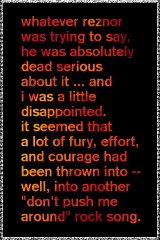
For me, the video was a double-whammy. I have a background in medical research, so my tolerance for gore is higher than that enjoyed by most people. I've also expended some effort learning about how special effects in film are achieved and just how real the FX artists can make things look. The quality of the tape I purchased was rather poor, too. These things were my armor, which I consciously donned, before watching the H.I.S. video for the first time (I'd read comments on electronic bulletin boards about how gross it was).
On the first viewing, I was able to be impressed with how well they'd pulled it off, how perfectly in keeping with the other uncensored NIN videos it was. So the first "whammy" was essentially that it was unavoidably obvious that Mr. Reznor wasn't just fucking around with this song. Whatever he was trying to say, he was absolutely dead serious about it. With this, he'd gotten right in our faces and he wasn't going to back down. And I was a little disappointed. It seemed that a lot of fury, effort, and courage had been thrown into -- well, into another "don't push me around" rock song.
Two weeks later, I learned the identity of the docile mope in the video who'd fed himself so calmly into the torture machine. It was sheer accident that I happened to know who Bob Flanagan ("Supermasochist") was. I felt like I'd been kicked in the gut. The only reason I could conceive of for selecting him for the video was that some of what was done to him had been real.
I spent a really bad week wondering if I should check myself in to a therapist. What kind of person could I be, to be so intrigued by someone who would really torture somebody for a lousy rock music video? Just how sick is Trent Reznor anyway? And how sick am I?
Rationalization is a wonderful thing. It worked for me. When I finally calmed down I realized that I'm no sadist. And that that gut-wrenching process could well have been exactly the kind of impact that Reznor was aiming for. The only way to achieve it would be by using someone like Flanagan. If Reznor's smart (and all the evidence suggests he is), he'll never reveal how much, if any, of the H.I.S. video torture was real.
But knowledge of Flanagan's identity opened new doors of meaning in the song, and the video. I was right. Reznor wanted this right in your face: Run away from this.
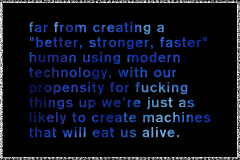
Again, there is more than one level working. With the grainy, merciless black-and-white camera work, the unflinching, anti-erotic nudity, and the impassive footage of torture, he's created an enraged visual metaphor for the grinding down of the human soul to serve society's purposes.
The inexorably pounding, rotating, ratcheting, spewing machinery, blended with nightmarish swoops through the dungeon's "greenery" -- including sundews and pitcher plants and Venus' flytraps, flesh-eaters all -- achieve a visual industrial poetry that so directly expresses "industrial" rock's thesis that it's hard to imagine anyone ever doing it better. That "dentist's chair" itself seems alive. The end product of the Everyman's self-sacrifice, a bolus of macerated flesh, is extruded from under the device through spasms of a sphincter-like iris diaphragm down to the writhing worms and hungry flytraps. Here's the dark side of the Six Million Dollar Man concept: Far from creating a "better, stronger, faster" human using modern technology, with our propensity for fucking things up we're just as likely to create machines that will eat us alive.

And Bob Flanagan himself -- because of who he was -- sharpens the bite of the message. Anyone who's enamored of judging others can pontificate about the evils of the S&M world. But confronted with Flanagan's story, only a monster could cling to her pious condemnation. Born with cystic fibrosis, Flanagan as an innocent child suffered more than most humans could ever deserve in a lifetime of sinning. That he was able to turn such an affliction into a source of pleasure, even art, through the power of his mind and spirit is an astounding tribute to that spirit. Yet you would never have read about that triumph in the "Inspirational Stories" section of your newspaper's Sunday supplement. The American readership loves stories about taking life's lemons and making lemonade -- but only if you stay within "the boundaries." Reznor's and Flanagan's video is an unanswerable challenge to our own boundaries, of compassion.
I wonder if there are people who would prefer that Mr. Flanagan had settled for suffering and omitted all that un-Christian sexual stuff. Does that seem harsh? Perhaps it is, for this era. There have been times when people have done even worse, in the name of religion. I've been told that in the Baroque period of European history, certain clergy employed novel methods of choir-building. Convicts' vocal cords were surgically altered so each could utter only at a single vocal pitch, some higher, some lower. The good men of the cloth would then torture the miscreants selectively so that their screams, in sequence and combined, created hymns that soared to the very gates of Heaven. (Do you suppose God appreciated it?)
It took months before I realized that the melodic motif in the Fixed version of "Happiness In Slavery" had been devised by setting Bob Flanagan's screams to music, and recreating them instrumentally and electronically. (Then I recalled that the very first clear glimpse I got of Reznor's face, in a clip of an MTV interview, immediately evoked a memory of an old painting of a defrocked Florentine cleric. Hmm....)
The mood of this version is more ominous, and its syntax more abstract. If we consider the Broken H.I.S. the "parent" piece (keep in mind I don't know the order in which these were made; I'm going by the sequence of album releases), its lineage is still recognizable in its Fixed namesake. All the melodic themes are still there, though rearranged and interspersed with synthesized, "sampled," industrialized effects, and dominated by the Flanagan leitmotif throughout. Only one word of the lyrics appears -- distorted shrieks of "Slavery!"
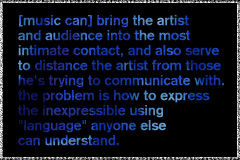
It's not a happy little number, but alone (if you hadn't heard the Broken version) its message is certainly not obvious. Could be an anti-slavery anthem. Maybe something written for those fun folks at the leather clubs. While Broken was the "wall of rage," Fixed is an even darker work. Imagine the difference between someone screaming in your face that he's going to kill you, and the same person suddenly going quiet, nodding to himself, and disappearing back into the shadows. Not that Fixed is literally quiet. With its single-word lyric, however, H.I.S. has withdrawn its author's attempts to communicate on normal levels. It's still an essentially musical-sounding piece; it's as though some part of Reznor still wants to be understood, while withholding that part of the song that could enable that understanding.
All true art strives to express the inexpressible. Because we're a visually oriented species, often the visual arts are the most successful. However, the mind tends to immediately attempt to verbalize what a painting, sculpture, or scene evokes in the heart. Perhaps because we are less attuned to our sense of hearing, music can dig deeper -- bypass the rationalizing at least temporarily -- and play around in our emotions more effectively. It's the closest thing we have to a universal abstract language. Because of this it can, at the same time, bring the artist and audience into the most intimate contact and also serve to distance the artist from those he's trying to communicate with. The problem is how to express the inexpressible using "language" anyone else can understand.
"Screaming Slave" is almost the opposite of the Fixed: H.I.S.; in this track, it's the music that's almost completely abstract, and the remixer has put the lyrics back in -- not all of them, but enough to sketch in a portrait of the one who's singing/who's sung about/who's singing/who's sung about...it's a house of mirrors, a twisting maze. Reznor introduces the ride with the reversed phrase, "Human junk just words and so much skin" to the accompaniment of dentist drills and nerve-shredding industrial squeals, ominous drums, electronics in distress. Even the incongruously jaunty "ramp" from Broken: H.I.S. has been given a dark, threatening half-turn. At the heart of the maze Mr. Flanagan lies screaming, not alone this time. A man and a woman, in dim, almost entirely obscured voices, seem to be idly discussing what they're doing to him. Until the screams stop, and the woman says distinctly, "He's dead." Then the mechanical howls and shrieks, whines and roars and distorted percussion, start up again, leading us out into the foyer, where Reznor is again assuring us, "It controls you."
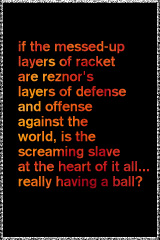
Reznor has been accused of sociopathy, by people who probably don't know what the word means. At the very least it's easy to believe he wants to self-isolate. Yet he's an artist, and an artist needs viewers, or listeners. He needs to reach out to others. So he's caught in another dilemma, one reflected in the language conundrum mentioned before. How to communicate without stooping to a common language? How to perform without an audience? It's impossible. He can't fulfill the need to express what's inside him without the pain of dealing with other people. The more I listen to and think about "Screaming Slave," the more sly I think its message is. It's a cacophony of ugly sounds, leading you down into the ugliest sound of all -- the screams of a man being tortured. But...think about who this particular man is. This particular man...likes the pain. If you listen hard enough, you can almost believe you hear the sexual pleasure in his screams. If the messed-up layers of racket are Reznor's layers of defense and offense against the world, is the screaming slave at the heart of it all...really having a ball?
If you spend a lot of time listening to the NIN albums and singles, what emerges is an image of someone dancing at the rim of Hell...and sending back postcards. "This is what it's like," he says, and anyone with any knowledge of themselves has to admit that "I, too, have been there...and will be again." We like to forget how essentially bizarre it is to exist. Reznor reminds us. He paints the postcards in Technicolor and wraps you in SurroundSound. You can ignore it but you can't deny it. Being human is a constant struggle between the need to be "I" and the survival necessity to be a part of "we." That friction is the source of our greatest joys and our most devastating pain. The question in the shadows behind us is, "Is it worth it? Wouldn't oblivion be preferable?"
I think that if Reznor's answer to that question was, "Yes -- give me oblivion," he wouldn't be alive. I think that, like Bob Flanagan, he's made the choice to dig into the anguish of existence and find the beauty in the terror.
Name a more courageous gift to the world. Too bad so few have the answering courage to thank him for it.
Terry Hickman lives in Omaha, Nebraska. Write to her
care of Hope and Vaseline (hnv@nin.net).
hope and vaseline -- hnv@nin.net
![]()
![]()
![]()